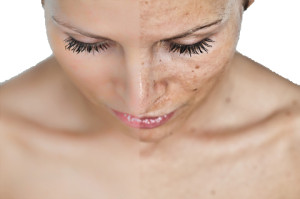 Melasma is a dark skin discoloration that appears on sun-exposed areas of the face. Melasma is particularly common in women, and more prone to developing darker skinned individuals such as Hispanics or those of Middle Eastern descent. It has a strong correlation to female hormones and sun exposure. Therefore, pregnant women and those who are taking oral contraceptives or other hormonal therapies are at the highest risk. Sun exposure is also a strong risk factor for melasma as is thyroid disease.
Melasma is a dark skin discoloration that appears on sun-exposed areas of the face. Melasma is particularly common in women, and more prone to developing darker skinned individuals such as Hispanics or those of Middle Eastern descent. It has a strong correlation to female hormones and sun exposure. Therefore, pregnant women and those who are taking oral contraceptives or other hormonal therapies are at the highest risk. Sun exposure is also a strong risk factor for melasma as is thyroid disease.
The presence of Melasma is marked by dark, uniform brown color that appears as irregularly shaped patches found on the upper cheek, nose, lips and forehead. Melasma doesn’t cause any other symptoms besides skin discoloration but may be of great cosmetic concern. It is most often symmetrical (matching on both sides of the face).
Conservative management begins with strict avoidance of sun. The use of sunscreens with physical blockers, such as titanium dioxide and zinc dioxide is preferred over other sunscreens. Topical treatments include bleaching agents such as hydroquinone, Retin-A and antioxidants.
Melasma can occur in the superficial and/or deeper layers of the skin. A closer examination using a Wood’s lamp may help guide your treatment. Determining where the increased pigment is accumulating helps in deciding, which of the several treatment options will be best for the patient. The most effective treatments involve the combined use of topical therapy and lasers. As always, strict protections against the harmful rays of the sun are mandatory.
There are several lasers that are used depending on the patient’s skin type, the severity of the condition and the depth of the pigment. Superficial lesions can frequently be managed by a Photofacial, while deeper lesions will respond best to Laser Skin Resurfacing and/or Fractional Skin resurfacing.
